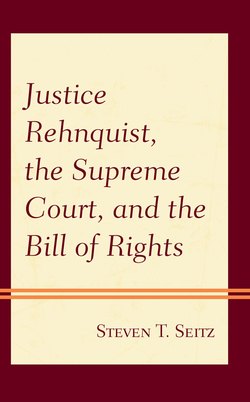Justice Rehnquist, the Supreme Court, and the Bill of Rights

Реклама. ООО «ЛитРес», ИНН: 7719571260.
Оглавление
Steven T. Seitz. Justice Rehnquist, the Supreme Court, and the Bill of Rights
Preface
Introduction
The Book’s Focus
Non-Economic Due Process
Justice Rehnquist v Sustainable Case Law
Original Interpretation
Living Constitution
Thematic Chronology
Commentaries on Commentaries
The Two Constitutions
Separation of Powers
Size of Constituency
Enumerating Rights
Individual Sovereignty
Multiple Sovereignties
Judicial Politics
Slow Change
Interpreting Clauses
Originalists and Living Constitution
Natural Law and Natural Rights
Conclusion
Note
Dred Scott
The Dreaded Decision
Race and the Constitution
To Sue
Law and Politics
Land and Boundaries
Master/Slave
Citizenship(s)
Concurrences
Dissent
State Abolition
Unrepentant
Conclusion
Privileges and Immunities
Slaughterhouse
The Butchers
Intervention
Different Visions of Privileges and Immunities
Slaughterhouse Dissents
Paul
Ignoring the Civil Rights Amendments
Slaughterhouse Redux
Privileges, Immunities a Century Later
Rehnquist’s decision in Building Trades
Similar Cases, Opposite Results
Wither Rehnquist?
Rehnquist Court—Hicklin
From Occupation to Recreation
Conclusion
Note
Due Process
Debtors
The Munn Case
Munn Dissent
Due Process and the Taxing Power
Railroads
Munn Redux
Takings and the Public
Taxation and Takings
Insurance
Technology and Environment
Pullman
Taxes and Due Process
Regulation and Due Process powers. Police Powers
State Sovereignty
Property and Race
Public Health
Banks
ICC
Home-Owners Association
Public Interests
Corporations
State and Local
Interstate Commerce
Administration
Financial
Professionals
Family
Property Interests
Rehnquist Enters
Disability
New Wine, Old Skins
Children
Environment
Boy Scouts
Technological Change
Conclusion
Criminal Process
Mental Illness
Habeas Corpus
Grand Juries
Due Process
Legislative and Judicial Due Processes
Morals
Food
Immigration
Liquor
Incorporating Rights
More Immigration Woes
Counsel
Double Jeopardy
Defendants and Due Process
Conclusion
Equal Protection for Women
Marriage
Dower
Women and Contracts
Serving Government
Women and the Military
ERA
Using Equal Protection
The Physical
Conclusion
Note
Asserting Federal Power
Land
Land Claims
Lottery
Navigation
Officers
Court Personnel
Loans
Conclusion
Contracts
Takings
Railroads
The Sinking Fund Cases
Dissenting Voices
Public Funds, Private Ownership
Due Process and Equal Protection
Contracts
Infused with a Public Interest
Lochner
Conclusion
Free Speech and Corporations
Natural and Artificial Persons
Incorporation
Standing
Sovereignty
New York Times v. Sullivan
Corporations or Press
Reporters
Press and Politicians
Press and Public
Political Campaigns
Corporate Speech
Central Hudson
Austin
McConnell aka BCRA
Citizens United
Conclusion
Sex. Conscience and Consciousness
Race
Contraception
The Unborn
Adultery and Homosexuality
Type of Sex
Social Darwinism
Protecting Children
Obscenity
The State and Marriage
Homosexuality
Privacy and Intimacy
The State and Sexual Behavior
The Nature of Explanation
Guns. Amendment 2 : The Right to Bear Arms
Three Interpretative Phases
Cruikshank
Keeping and Bearing Arms
Presser
Individual Right to Bear Arms
Heller
McDonald
Conclusion
Note
Conclusion
Cases Cited
Index
About the Author
Отрывок из книги
I want to thank members of the Computational Modeling Laboratory, University of Illinois, especially Charles Hulin with whom I have collaborated on many projects over the years. Regardless of content, my CML colleagues have persevered through many long manuscripts and offered thoughtful and helpful comments. We continue to develop our model of the smart page, which includes a multidimensional lazy Susan floating column of every source of information a user might wish to access for any word or phrase while reading a text page. The floating design allows the user to look behind words and phrases in the reference panes presented on the lazy Susan. Modeling the chronological development of topics across court decisions is much more complicated than might appear, because justices sometimes shift the case precedents from one legal line of reasoning to another, even though the basic facts of the case bear striking resemblance to other cases buried under a different line of legal reasoning. These lateral shifts are more frequent than changing or overturning precedents. Accounting for these lateral shifts requires a complex rule base larger and more complicated than the rule base for vertical shifts overturning or marginalizing precedents. The research presented in this book has been instrumental in advancing the computational work.
Charles Warren’s great book The Supreme Court in United States History developed an excellent historical picture by term and has been helpful in illuminating the nature of the times. The chronologies by topic developed in this and a previous book, The Supreme Court, the Constitution, and Justice Rehnquist, are essential for developing the genetic picture of a dynamic court. In his preface, Warren suggested he should have developed the book by themes, but development by terms was much more manageable when he started his book in the early 1920s. The new books help address this void and allow progress on the large rule bases for the computational model. The concurrences and dissents have been instrumental in elaborating the rule bases.
.....
Those who wrote the Constitution and Bill of Rights used terms general enough to allow the court to expound a Constitution, expound the protected sphere of individual citizens, and in some cases, expound protections for noncitizens as well. Marshall’s Living Constitution stands at odds with the counternarrative that our contemporaries can reconstruct the intent of people dead for more than two centuries or the public understanding long since passed and the related situ with which these ghosts of the past interacted. Divining intentions of people or publics long since passed, or selectively writing their history by choosing the important publics of the time provides the cover and flexibility to import politics into judicial decision-making. Importing the mind and knowledge of the eighteenth century, to the extent possible, is an odd devotion. Either narrative still expounds a Constitution; both value consistency. The very art of interpretation, emphasis on interpretation, is an ideological exercise.
1.
.....